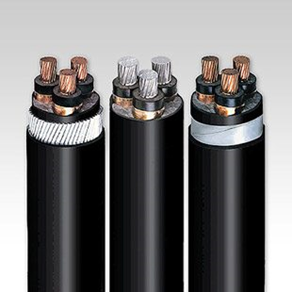Power cables
 Fig.1. Medium voltage cables 1
Fig.1. Medium voltage cables 1
Cable parameters
Voltage
In DriveConstructor voltage rating of a cable is being chosen automatically according to the voltage at the electric machine terminals.
Length
We limit the possible cable length to 5 km, so the range to choose from is 0 to 5000 m
Cable cross-section
Cables are produced with standard cross-sections of their phase conductors. We can choose from the row: 0.5, 0.75, 1, 1.5, 2.5, 4, 6, 10, 16, 25, 35, 50, 70, 95, 120, 150, 185, 240, 300, 400, 500, 630, 800 and 1000 .
Conductor material
In DriveConstructor, as well as in the real life, the choice should be made between copper and aluminum cable. Some arguments are presented below.1
Considering weight and size
For the same conductivity the weight of an aluminum cable will be only 54% of the weight of a copper cable, but the cross-section of the aluminum cable will be higher than that of the copper cable by 56%. So the choice will be a greater cable cross-section or a higher cable weight. Copper cable is thinner but heavier.
Considering cost
Generally speaking, aluminum cable will be cheaper. However, copper cable is more ductile and less susceptible to electrical contact problems. Due to its smaller cross-section, the copper cable will also be easier to install as the stiffness of the cable depends on the square of the cross-sectional area and thus on the fourth power of the diameter. So one should take into account the extra cost and effort involved in installing the less pliable aluminum cables.
Number of runs
The surface of the cable increases not proportionally (actually slower) with increase of the cable’s cross-section, therefore, for a thicker cable heat dissipation is less intensive and the current density should be decreased compared to thinner ones. So, in some cases it may be more economical to have two or more parallel thin cables (two or more “runs”) with higher current densities than one big cable with lower current density. In DriveConstructor it is possible to choose number of runs from the following options: «auto», 1, 2, 4. When “auto” is chosen, DriveConstructor will calculate optimal number of runs automatically.